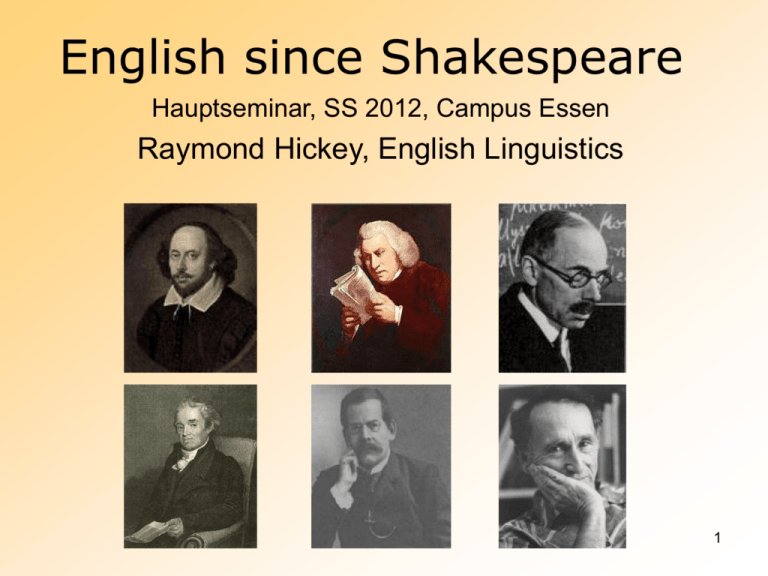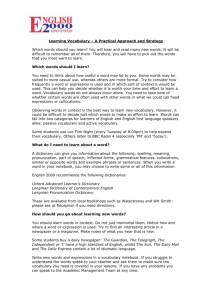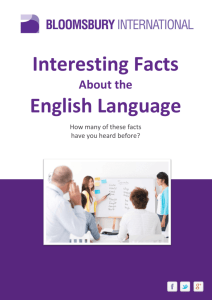A General Dictionary of the English Language
advertisement

English since Shakespeare Hauptseminar, SS 2012, Campus Essen Raymond Hickey, English Linguistics 1 Shakespeare’s plays and the English of his time 2 Pronunciation in plays 1) /r/ was pronounced post-vocalically (car, card) 2) wh was pronounced [ʍ] (which, witch) 3) /ʊ/ was not lowered (but, pull) 4) /a/ before /f, s, θ/ was still short (staff, pass, bath) 5) /a/ after /w/ was not retracted (swan, war) 6) mid-vowels were not diphthongised (play, boat) 7) diphthongs /ai, au/ still centralised (time [təɪm], house [həʊs]) 8) /ɛ:, e:/ had not yet been raised to /i:/ (eat rhymes with great) 9) fewer instances of short /u:/ (book, cook, room) 3 Grammar Multiple negation in Shakespeare thou hast spoken no word / all this while / ... Nor understood non neither (LLL, 1880-2) love no man in good earnest, nor no further in sport neyther (AYLI, 196-7) I am not valiant neither (O, 3541) Is’t not enough, young man, / That I did never, no nor never can (MND, 780-1) 4 Older grammar in Shakespeare Use of old nasal plural with ‘eye' Come, thou monarch of the vine, Plumpy Bacchus, with pink eyne! (A&C, 1466-7) Use of older inflected form of ‘do’, i.e. ‘doth' That doth invert the attest of eyes and ears (T&C, 3116) Use of old genitive as possessive pronoun, i.e. ‘mine' But no more deep will I endart mine eye (R&J, 444) Use of ‘be’, and not ‘have’, as an auxiliary verb When we born, we cry that we are come to this great stage of fools (Lear, 3010) 5 English in the 17th century 6 Groups of authors from the late 16th to the mid 18th century The Metaphysical poets This is a group of poets who are taken to have started with John Donne (15721631) and whose work is characterised by extravagent comparisons, reserved feelings and a display of learning. The school continued well into the 17th century, among the later representatives is Andrew Marvell (1621-78). The major poetic figure of the 17th century is John Milton (1608-74), the writer of sonnets, elegies and the epics Paradise Lost (1667) and Paradise Regained (1671). He was also a significant pamphleteer and involved in political activities. Jacobean drama A general term for drama as produced in the reign of James I (James VI of Scotland, 1603-25). Indeed it continued into the reign of Charles I (1625-49) until the closure of the theatres in 1642. The most important dramatist of this time (apart of course from Shakespeare) is probably Ben Jonson (1572/3-1637) Restoration drama With the restoration of the monarchy in 1660 under Charles II (1660-85) the theatres were re-opened and a flourishing set in, chiefly of comedy, which lasted for much of the remaining 17th century. 7 Non-fictional literature Personal correspondence In recent years, much attention has been given by linguists working in historical sociolinguistics to private letters as a source of information on language use and language change. From the Middle English period onwards there are collections of letters which have been preserved, frequently consisting of the correspondence between members of a particular family, and which give insights into English of the time. One of the most famous families is the Paston family from Norfolk the members of which wrote a large number of letters to each other between about 1420 and 1504. Other sets of letters are the Stonor letters and the Lisle letters. Such collections exist for other varieties of English as well. The McMahon letters from 18th century Ireland offer insights into the nature of Irish English at the time. The letters in all these cases typically involve relationships within the family, business dealings and petitions from people outside the family to prominent members within (as with the Lisle and the McMahon letters). 8 Technical literature The early modern period sees the rise of literature of a technical nature. The great expansion in the natural sciences, one of the main legacies of the Renaissance, led to literature dealing with scientific topics. With regard to language, one can note the appearance in the 16th century and later of a large body of literature concerned with the structure of English, its orthography, pronunciation, grammar and vocabulary. One of the first and most important authors in this field is John Hart (died 1574), the author of An orthographie of English (1569), one of the first works which suggested a spelling reform for English. See the gallery of writers from the early modern period for information on other authors. 9 The question of a standard for English 10 16th and 17th century authors concerned with standard pronunciation John Hart (d. 1574) in An orthographie of English (1569) offers a reformed spelling of English so that ‘the rude countrie Englishman’ can speak the language ‘as the best sort use to speak it’. George Puttenham (d. 1590) in The arte of English poesie comments that ‘After a speach is fully fashioned to the common vnderstanding, & accepted by consent of a whole countrey & nation, it is called a language’. He then proceeds to mention that he regards the prime form of this language as ‘the vsuall speach of the Court and that of London and the shires lying about London within lx. myles and not much aboue’ About a century later, Christopher Cooper in his Grammatica linguae anglicanae (1685) stated that he regarded London speech as ‘the best dialect’, the ‘most pure and correct’, but he was quite liberal towards variation: ‘Everyone pronounceth them (words) as himself pleases’. 11 The Augustan age The early to mid 18th century was a period during which satire flourished in England (and Ireland). The main authors are Joseph Addison (1672-1719), John Dryden (1631-1700), Alexander Pope (1688-1744), Sir Richard Steele (16721729) and the Irish writer Jonathan Swift (1667-1745), the latter being particularly concerned with questions of language and entertaining generally conservative views on language change. The term Augustan is derived from the comparison of this age to that of the Roman Emperor Augustus under whose reign Horace, Ovid and Virgil flourished, authors who the latter-day English writers also admired. The middle of the 18th century sees the rise of the novel (initially in epistolary form) and the publication of the first major lexicographical work, the monolingual dictionary Dictionary of the English language (1755) by Samuel Johnson which was a model for all future lexicographers. (Johnson drew on the dictionaries of Nathaniel Bailey - such as the Universal etymological English dictionary (1721), with some 40,000 entries, and the Dictionarium Brittanicum (1730) - for the word list he used in his own). 12 13 Non-fictional literature of the 18th century 14 Journalistic literature Pamphlets A pamphlet is a piece of polemical writing, a booklet, aimed at a large audience. Pamphlets arose during the Reformation period as a means of spreading radical religious and political views and continued until well into the 18th century, for instance with the author Jonathan Swift. Periodicals Weekly periodicals largely replaced pamphlets (though there was a slight revival in the 19th century). These were often aimed at an audience interested in literature and contributed greatly to the dissemination of creative literature, for instance in their serialisation of major novels such as many by Dickens. At the beginning of the 18th century major literary figures, such as Addison and Steele, used the periodical to make their ideas known, e.g. with The Tatler (1709-11) and later The Spectator (1711-12). Later others arose, such as The Gentleman’s Magazine and The Analytical Review. The longest surviving of these was Blackwood’s Magazine which ran from 1817 to 1980. Among the various literary reviews which one could mention are the Monthly Review (1749-1845), the Edinbrugh Review (1802-1929), the Quarterly Review (1809-1967), the Examiner (1808-1881), the Westminister Review (1824-1914) and the Fortnightly Review (1865-1934). 15 Newspapers Newspapers have their origin in the early 17th century and stem from short, single-sheet publications with news from abroad, a subject of natural interest to colonial powers - something which explains why they were popular in Holland (present-day Netherlands). They quickly began to proliferate in England so that by the mid-17th century there were several produced in London. During the interregnum of the monarchy (from 1649 to 1660) they were largely suppressed but during the Restoration period began to flourish again. The major newspapers, which have survived into our times, were first published in the 18th century, for instance The Times was founded in 1785. In England national newspapers are published in London, the only significant exception being The Guardian (founded in 1821 as a weekly, after 1855 published as a daily) produced in Manchester. The term broadsheets is generally used nowadays for serious newspapers, usually in a large format, which are regarded as distinct from tabloids (in smaller format and of a more sensational character). 16 Lexicography in 18th century England 17 18 Codifying the English language 19 20 21 The rise of prescriptivism Thomas Sheridan (1719-1788) 22 23 Sheridan, Thomas (1719-1788) Irish writer, born in Dublin and educated in London and Dublin. He was first an actor and is the author of a farce The Brave Irishman; or Captain O’Blunder (1743; published 1754). Later he became a travelling expert on elocution. Sheridan produced A Course of Lectures on Elocution (1762), A Rhetorical Grammar of the English language (1788) and A General Dictionary of the English Language (1780) in which he gives guidelines for the correct use of English. 24 25 26 27 Sheridan A General Dictionary of the English Language (1780) 28 Sheridan A Complete Dictionary of the English Language (1796) 29 30 31 32 33 34 Pronouncing dictionaries of English Walker, John (1732-1807) 35 Walker, John (1732-1807) A Londoner and prescriptive author of the late 18th century, best known for his Critical pronouncing dictionary (1791) which enjoyed great popularity in its day. 36 Just as Samuel Johnson had saught patronage for his dictionary from Lord Chesterfield (Philip Dormer Stanhope, 1694-1773), John Walker appealed to David Garrick (1717-1779) for similar support for his dictionary. Both authors did this by dedicating the plan for their respective dictionaries to their would-be patrons. 37 John Walker 1775 Rhyming Dictionary of the English Language London 38 39 40 John Walker 1785 A Rhetorical Grammar or Course of Lessons in Elocution London 41 Comparison of publication dates for Sheridan and Walker 42 43 44 45 46 47 48 49 50 51 The chronology of recent sound changes 52 English in the Southern Hemisphere 53 Division of the world by anglophone varieties 54 Southern hemisphere Late 18th century In 1770 James Cook seized the east coast of Australia which was subsequently called New South Wales. White settlement of Australia begins in 1788 in the area around Sydney. Turn of 19th century In 1795 the first English settlement at the Cape of Good Hope. 1820’s Second larger settlement at long the Eastern Cape region (roughly the area around Port Elizabeth) Mid 19th century In 1769 James Cook also visited New Zealand and formally claimed the island for England. But settlement only began in earnest after 1840 when the Maori ceded sovereignty to the British with the Treaty of Waitangi. Later 19th century Various English-speaking settlements are established on islands in the southwest Pacific, especially on Papua New Guinea. The form of English there develops into an expanded pidgin and later creole, Tok Pisin, which is present to this day. 55 Movements within the Anglophone world 17th century onwards Internal migration within the Caribbean, especially from smaller Anglophone islands — above all Barbados (first settled by the British in 1627) and Montserrat — to larger ones, e.g. Jamaica, and to some coastal points on the Caribbean rim, Miskito Coast in Nicaragua, Suriname (then British Guyana) where Sranan (an Englishbased creole) arose. In these cases local creolised forms of English thus spread to other regions, e.g. Bajan (Barbadian Creole) was transported off the small island of Barbados and very likely formed an input to Gullah, a creolised form of English in the United States still spoken by small isolated communities on the Sea Islands off the coast of South Carolina and Georgia. Early 19th century Freed slaves (in the 1820's) move to Nova Scotia, Samaná peninsula (Dominican Republic, north-east Isla Hispaniola) and to Liberia (West Africa) and take their distinctive forms of English to these locations. Later 19th century Movements of labour forces after the abolition of slavery in the British Empire in 1834, e.g. to Natal in eastern South Africa from India between 1860 and 1911. Furthermore, there were movements of Indian speakers from India to the 56 Caribbean in the 19th century, e.g. to Trinidad and Tobago (southern Caribbean). Early settlement of South Africa 57 Early settlement of Australia 58 Early settlement of New Zealand 59 English in the southern hemisphere At all the locations in the southern hemisphere, forms of English arose in which the input from south-eastern British English speakers dominated. In all these varieties we can confirm that they 1) 2) 3) are non-rhotic (car and card are without [r]) show raising of short front vowels (stemming from CATCH-raising) show a lack of aspiration in wh-clusters (which ~ witch homophony) Walker mentions all these features as typical of south-eastern British English of his day, hence we can assume that they were transported. Although the absence of initial /h-/ may well have been part of the speech of early anglophone settlers in the southern hemisphere, its stigmatisation would have militated against it becoming established in the emerging varieties of southern hemisphere English. The principle of relative chronology rests on a threshold before and after which change may or may not take place. Because T-glottaling, THfronting, L-vocalisation and HAPPY-laxing do not occur in southern hemisphere varieties we can assume that they had not arisen in southeastern British English at the time of initial emigration. 60 The aftermath of Sheridan and Walker: Both were held in great esteem and their influence can be recognised in the revamping of the originals which occurred in the 50 years or so after their deaths, consider the following examples (one for each author): Jones, Stephen 1798. Sheridan Improved. A General Pronouncing and Explanatory Dictionary of the English Language. 3rd edition. London: Vernor and Hood. Smart, Benjamin H. 1836. Walker Remodelled. A New Critical Pronouncing Dictionary of the English Language. London: T. Cadell. 61 The legacy of Sheridan and Walker: Did the strictures of Walker or Sheridan influence the later pronunciation of non-local British English? The answer to this question must be ‘no’. In some cases Walker, as opposed to Sheridan, favoured a form which was later to become default in English, e.g. merchant for marchant. But this did not happen because of Walker’s opinion on the matter. In many respects, Walker was swimming against the tide of language change. His insistence on maintaining regular patterns of pronunciation across the language (his ‘analogy’) and, above all, his view that the spoken word should be close to the written word, meant that he favoured archaic pronunciations. His view that syllable-final /r/ should be pronounced was already conservative in his day. In many of his statements he does, however, accept change although he might not have agreed with it. The legacy of both Sheridan and Walker should be seen in more general terms. Even if their individual recommendations were not accepted by standard speakers of British English, both were responsible for furthering general notions of prescriptivism. And certainly both contributed in no small way to the perennial concern with pronunciation which characterises British society to this day. 62 English in the 19th century 63 19th century to the present More than in any other European country England is marked by an emphasis on standard pronunciation. The type of pronounciation known today as Received Pronunciation (after Daniel Jones) or under other less precise epithets such as The Queen’s English, Oxford English, BBC English, etc. is a sociolect of English, that is, it is the variety of English spoken by the educated middle classes, irrespective of what part of England they may live in. In the nineteenth century and into this century as well, this accent of English was that fostered by the so-called public schools (private, fee-paying schools) which were the domain of the middle class. It is also the variety which foreigners are exposed to when they learn ‘British English’. 64 The Oxford English Dictionary 65 66 67 Prescriptivism in England 68 69 The codification of Received Pronunciation 70 71





